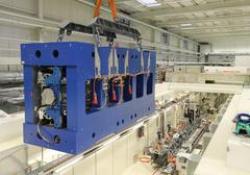Nov 24 2014
Researchers from PSI have spent the last four years developing key technologies for the X-ray laser SwissFEL and subjecting them to the acid test in the injector test facility. Now that the development programme has drawn to a close, the installation of the new large-scale research facility is due to get underway in early 2015.
 Installation of the undulator prototype in the injector test facility. The tests lived up to the expectations of the researchers – they managed to generate the first free-electron laser beam in Switzerland. Photo: Johan Wickström/PSI.
Installation of the undulator prototype in the injector test facility. The tests lived up to the expectations of the researchers – they managed to generate the first free-electron laser beam in Switzerland. Photo: Johan Wickström/PSI.
The free-electron X-ray laser SwissFEL will produce very short pulses of X-ray light with laser-like properties at a high intensity by generating electrons, bringing them to a high energy level with a linear accelerator and sending them on a slalom course using undulators, a special arrangement of magnets. As they zigzag, the electrons emit light, which intensifies itself strongly and culminates in the brilliant flash of X-ray light that is used for the experiments on SwissFEL.
High technological demands
Only around 570 metres of the roughly 740-metre-long facility are actually available to generate X-ray light in SwissFEL. The compact structure of the Paul Scherrer Institute’s new large-scale research facility necessitated numerous technological refinements and new developments. Once completed, SwissFEL will be one of five free-electron X-ray lasers in the world. Compared to the other facilities, however, it will work with a considerably lower beam energy level.
For the SwissFEL X-ray light to be produced despite this low electron energy, an extremely high-quality electron beam is required. “It needs to be perfect from the outset,” explains Thomas Schietinger, head of the Accelerator Concepts Section at PSI. Consequently, a development programme was launched at PSI four years ago, which concentrated on the initial part of the facility that generates the electrons, gives them their first acceleration thrust and focuses them: the injector.
Tests under realistic conditions
In the injector test facility, feasibility studies were conducted and key technologies developed, tested and optimised. In doing so, the researchers ventured into unchartered technological territory: “We had to demonstrate that the electron beam required could actually be generated and characterised,” stresses Marco Pedrozzi, head of the injector test facility.
Once this had been achieved, the PSI research team headed by Schietinger worked hard to optimise the beam quality and make sure that it could be sustained over the entire accelerator course. The electron beam was put to an initial acid test after the installation of an undulator prototype: “The results of operating the beam with an undulator lived up to our expectations – we managed to produce the first free-electron laser beam in Switzerland,” says a delighted Schietinger.
The last few months in operation were devoted to testing the electron source that will generate the electrons in SwissFEL. It is to be moved to the SwissFEL building in mid-2015, where the two-year installation of the facility is due to get underway at the beginning of 2015. Pedrozzi reflects on a successful development programme: “Thanks to our tests under realistic conditions, we were able to make a key contribution to its successful realisation.”
Text: Paul Scherrer Institute/Martina Gröschl